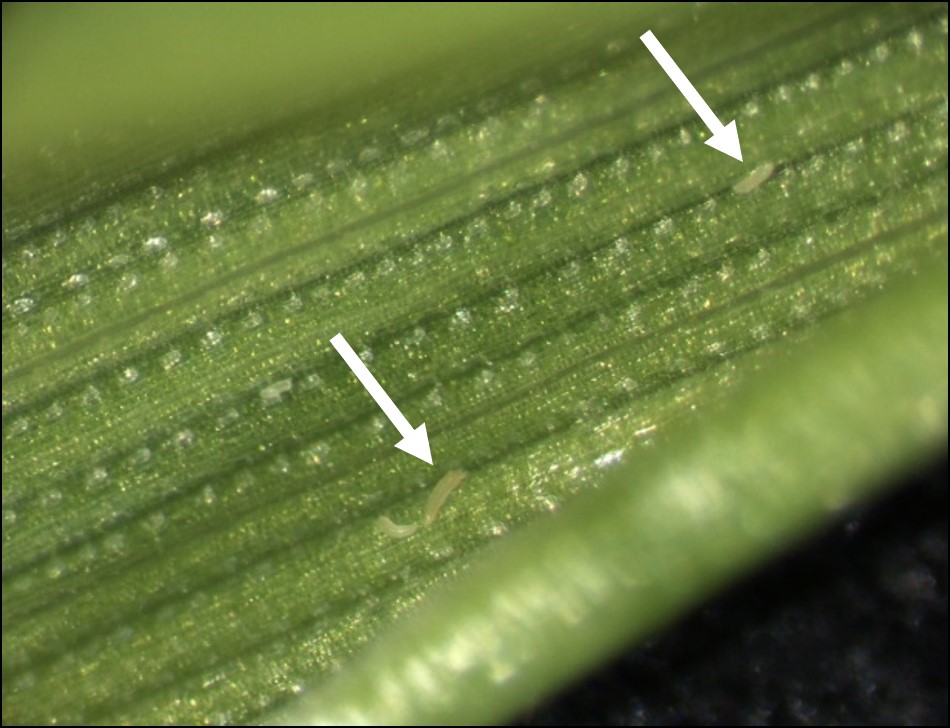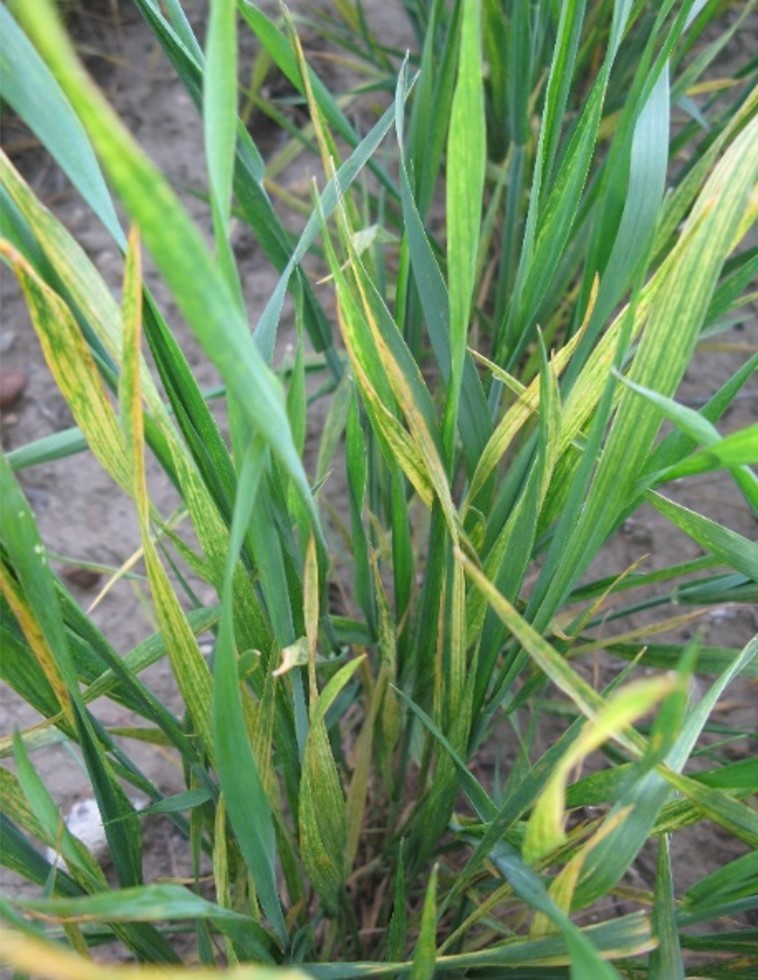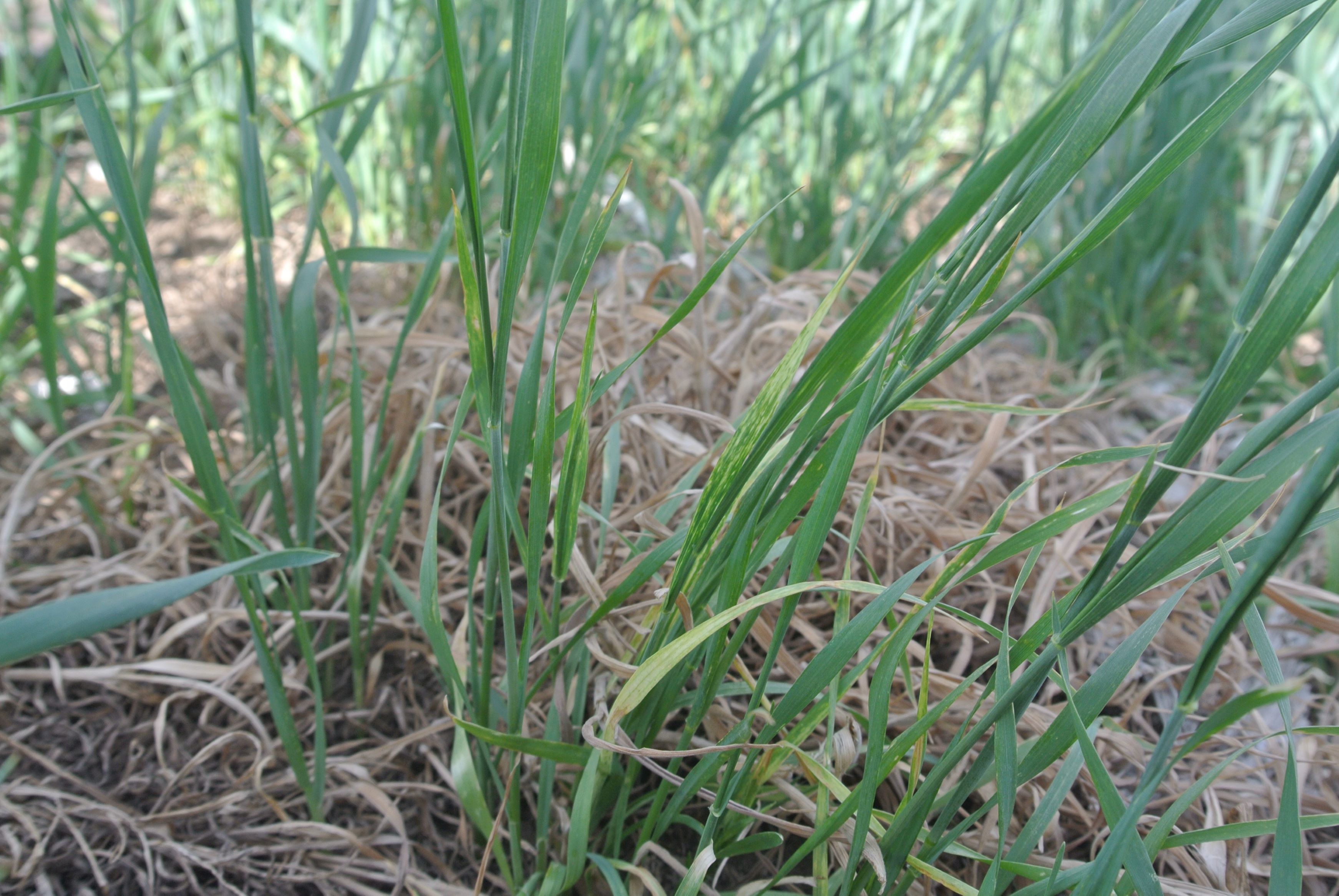Wheat Streak Mosaic FAQs
By Uta McKelvy, Extension Pathologist, Montana State University and Andrew Friskop, Extension Pathologist, North Dakota State University
Wheat streak mosaic is a common and economically important disease of small grains in the Great Plains States, including Montana and North Dakota. The disease tends to be most damaging in production areas where fall-sown small grains overlap with spring-sown small grains. This publication answers commonly asked questions to help identify and manage wheat streak mosaic.
What are the causes of wheat
streak mosaic?

Figure 1. Wheat curl mites transmit viruses of the wheat streak mosaic complex. Using a magnifying glass, mites can be observed in rolled-up leaves or near the leaf base. (Photo: Dai Ito)
Wheat streak mosaic is a viral disease caused by three viruses in North America: Wheat streak mosaic virus (WSMV), High Plains wheat mosaic virus, and Triticum mosaic virus. These viruses can occur in the same field and even in the same plant, and we refer to this as a virus complex. WSMV tends to be the most common of the viruses. All three viruses are transmitted by the wheat curl mite, which is a tiny (1/100 inch) wingless arthropod that overwinters in the crowns of host plants and effectively transmits the viruses between host plants (Figure 1).
How do I recognize wheat streak mosaic in the field


Figure 2. Top: Close-up of wheat streak mosaic infected wheat plants with yellow streaks.
(Photo: Mary Burrows)
Bottom: Wheat streak mosaic infected winter wheat field showing stunted, yellow-looking
plants.
(Photo: Monica Brelsford)
Yellow to pale green stripes creating a mosaic-like pattern on the foliage is a characteristic symptom of this disease (Figure 2). Severe infections will result in stunted plants, poor tiller development, and shriveled or no grain. Symptoms often appear first on the field edges or in pockets in the field where volunteer wheat and other hosts occur. Other plant diseases, environmental effects, and nutrient disorders can cause similar symptoms. Therefore, the best way to confirm wheat streak mosaic is to send a plant sample to a plant disease diagnostic lab.
Are all hosts equally susceptible to wheat streak mosaic?
There are many hosts for wheat streak mosaic, but they are not all equally susceptible. The most susceptible hosts support wheat curl mite populations and are susceptible to one or several of the viruses in the complex. Winter and spring wheat are very susceptible crop hosts. Barley, durum, rye, corn, and other cereal crops can also host the mites and viruses. Downy brome (cheatgrass) also hosts wheat curl mites and viruses and acts as a source of infection in the Northern Great Plains.
How much yield loss can I expect?
Yield loss from wheat streak mosaic depends on the cultivar planted and the timing
of infection. Yield
losses will be most severe if plants become infected in the early stages of plant
growth in the fall or
before tillering, which can result in complete crop failure. Some winter wheat cultivars
are resistant to
wheat streak mosaic or tolerate the disease with little impact on grain yield. One
example is the
cultivar Brawl CL Plus which had consistently low WSMV incidence and only small yield
losses in
Montana field experiments. Spring infection of susceptible winter wheat cultivars
(at the 3-4 leaf stage)
resulted in grain yield losses as high as 50% in field experiments. There are no spring
wheat cultivars
with resistance to wheat streak mosaic available, and yield losses ranged between
30 and 80% in
Montana field experiments.
What can I do to prevent the disease from infecting my crop?

Figure 3. Wheat curl mites and wheat streak mosaic viruses may spread from volunteer wheat and
grasses, that have not been managed or managed too late, into the new wheat crop and
infect it with
wheat streak mosaic. (Photo: Andrew Friskop).
There are no cures for wheat streak mosaic once a crop is infected. Therefore, preventing infection is the most effective strategy for managing the disease. An integrated strategy is strongly encouraged. The green bridge, which describes weeds and volunteer crop plants that harbor wheat curl mites and viruses between crops, perpetuates wheat streak mosaic disease from one cropping season to the next (Figure 3). Disrupting the green bridge is an effective strategy for managing wheat streak mosaic. For example, do not plant winter wheat when small grain volunteers are present. Instead, eliminate volunteer plants by tilling or spraying herbicides and wait at least two weeks after the plants are dead before planting winter wheat. Avoid early winter wheat planting, especially if you anticipate a warm, extended fall; this will reduce exposure of young winter wheat plants to dispersing wheat curl mites. If wheat streak mosaic risk is high, consider planting a winter wheat variety that is more tolerant to the disease or planting a non-host crop (i.e. broadleaf crops such as pulses or canola).
How can I assess wheat streak mosaic risk?
Montana State University has developed an online learning tool called AWaRe – Assessment
of Wheat
streak mosaic Risk that demonstrates the most important factors related to the disease
risk in the
Northern Great Plains. The tool is free and available at the Plant Pathology Resources Page.
HELPFUL RESOURCES ON WHEAT STREAK MOSAIC
MSU Schutter Diagnostic Lab
Montana State University
119 Plant BioScience Bldg
P.O. Box 173150
Bozeman, MT 59717-3150
NDSU Plant Diagnostic Lab
North Dakota State University
1402 Albrecht Blvd.
Walster Hall, 306
Fargo, ND 58102
“AWaRe – Assessment of Wheat streak mosaic Risk in Montana” online tool
“Cereal Viruses of Importance in Montana,” MSU Extension MontGuide (MT200911AG)
Grow Plant Health Exchange, Focus on wheat
“Managing Wheat Streak Mosaic,” UNL Nebraska Extension Publications
